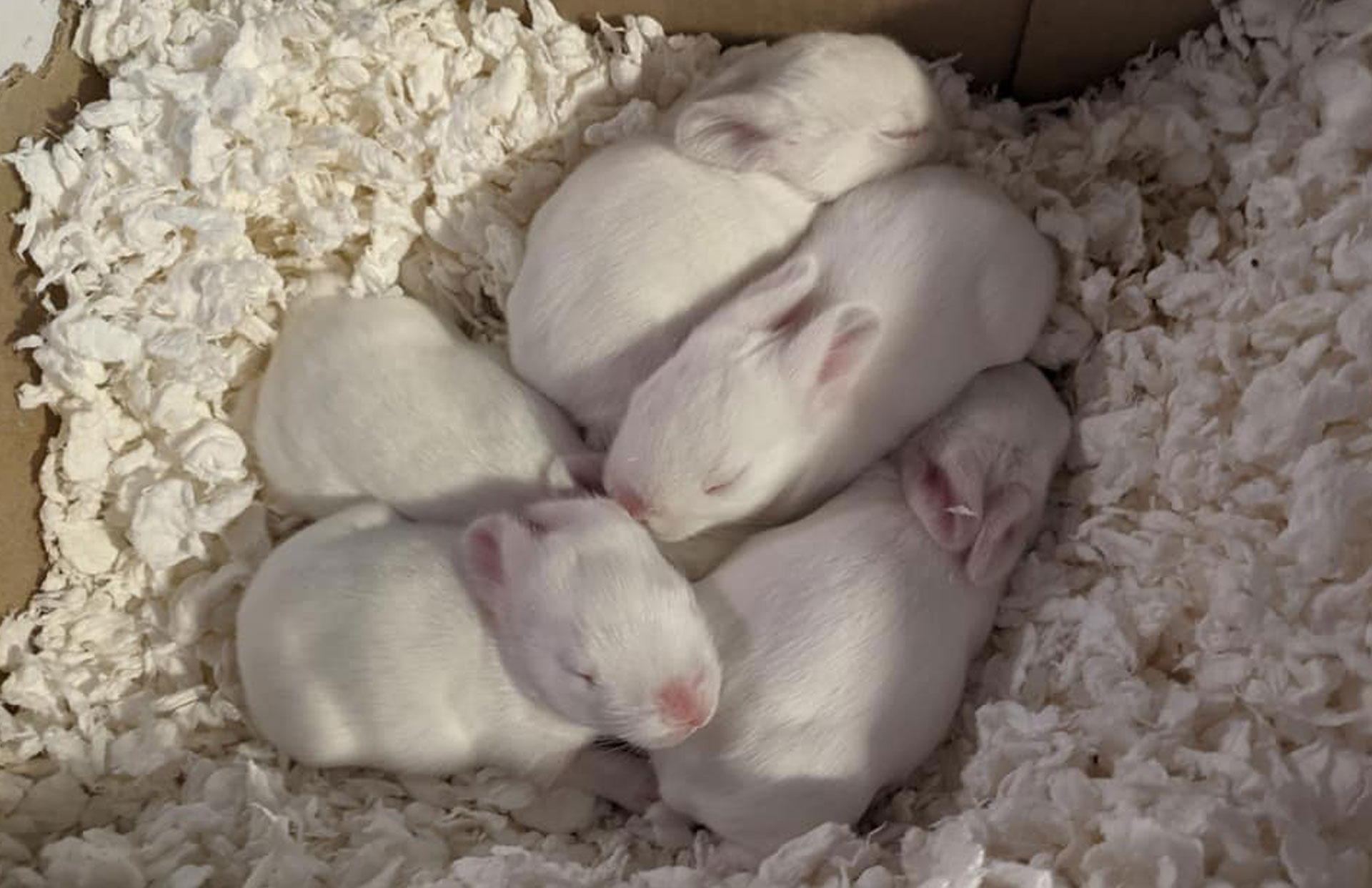It was a cold afternoon in December 2020 when a good Samaritan called to report two domestic rabbits hopping around a parking lot, almost as if trying to get someone’s attention. As I was making drive to the location, the number of rabbits grew from two to six. By the time we had caught all of them, the number had grown to 20. Miraculously, only one of the rabbits was pregnant—we named her Rowan.
You aren’t alone if you’re an advocate of spay/neuter and yet have found an unexpected litter of rabbits from a rescued rabbit in your home. When we took Rowan in from the cold that night, it was difficult to get a non-emergency veterinary appointment. Rowan showed no signs of immediate danger and also needed to be quarantined due to RHDV2 to protect my rabbits and the foster rabbits in my home. (Editor’s note: House Rabbit Society recommends quarantining any new rabbit for 14 days due to RHDV2 and vaccinating them as soon as possible.) It was a surprise when, days after Rowan arrived, I entered the quarantine area, looked at the hay in her litter box, and saw she had pulled fur and made a perfect little nest for five tiny newborns.
Let me preface the rest of this story by telling you I take in geriatric rabbits, typically with health conditions, so I had no idea what to do with newborn babies and a nursing mother. Even so, a litter box made of pelleted bedding and hay seemed rather rough for newborns, so I took a cardboard box that was large enough for Rowan to get in and out of comfortably, and I lined it with Carefresh-type material. I also put the fur she had pulled on top of the bedding. I talked to her and made sure she knew I was moving the babies. She watched me the whole time but was completely unphased by the process. As I was moving them from one space to another, I took advantage of the fact I was already disturbing everyone, and I took initial weights of the babies. Even at just a few hours old, each one had something distinguishable about them—and their weights were also slightly different. I wanted to make sure each of them continued to gain weight and for that I needed a baseline weight, collected using a kitchen scale. I placed a tissue on top and zeroed out the scale before weighing each baby. As the babies got bigger and began to wiggle, I used a small cardboard box to hold them and eventually graduated from a kitchen scale to a baby scale I purchased from Amazon. (By the time I needed a baby scale I was weighing them more for my own curiosity than out of necessity.)
Rowan watched me move the babies so dispassionately I was a little worried. But as soon as all of them were moved, they began making little noises I started referring to as “meeping” and Rowan quickly got up, hopped into the new nest box, and began nursing. It should be noted nursing rabbits typically feed once daily early in the morning, and sometimes twice, but no more than that. This is always a concern with people raising baby rabbits—sometimes you might not see the babies nurse, which shows how important it is to weight the babies daily. One piece of advice I received from a veteran fosterer was to offer Rowan plenty of dandelion greens and fennel, as it’s thought those might help increase her milk supply. I also made sure she was getting unlimited access to good quality pellets and alfalfa hay so she could begin to recover some weight after being outside and then giving birth. Rowan was a champ at nursing and all five babies seemed to thrive, each with marked weight gains every day. For my own peace of mind and to help keep the babies used to being handled, I checked their weights at the same time daily to see how they were progressing. This also offered an easy time to regularly clean their nest box. It’s important to know it’s acceptable to handle the babies and that by cleaning the nest you aren’t going to cause the mother to reject her babies. Changing the bedding can help prevent bacterial infections and help babies to stay healthy by preventing them from staying in their waste.
Caring for a Litter
If you’re needing to care for a litter of babies, you’ll want these supplies. Talk with your local HRS chapter or rabbit recue and a rabbit-savvy veterinarian for more suggestions!
- Bucket bottom cage or an x-pen lined with plastic or cardboard panels
- Soft blankets for lining the floor
- A nest box lined with a soft blanket, soft bedding, and fur from the mother that 10-day old babies can’t escape from
- A litter box for the mother
- Water bowl
- A kitchen scale
- Nipples and goats’ milk as supplements if milk production is low
- Unlimited alfalfa-based pellets
- Unlimited alfalfa hay
- A covered, private space for the mother
I was also surprised by how fast milestones occurred. By day two, all the babies had developed “peach fuzz,” and by day five, I could tell some were developing colored points like their mother. Each of the others had distinguishable markings as well. It was much too early to tell sex, but they all earned nicknames at this point because it was possible to tell them apart by size and features. I was fortunate to have others to talk to about weight gains—some babies gained considerably faster than others and that’s normal. The most important thing is that everyone continues to maintain and gain weight during the first week.
On day nine, the babies began truly gaining control of their limbs. So much so that there was a coordinated effort to push one of the siblings out of the nest box! We were past the 2-week RDHV2 quarantine period for Rowan, and I moved the rabbit family to a place in my house where we could monitor them better. The babies still had their eyes closed, but two were clearly ready to open them and start moving around.
There’s nothing quite like baby bunnies to motivate you to bunny-proof! By day 11, they were moving about and small enough to slip through an exercise pen. Keep in mind baby bunnies can escape enclosures. If you need to house babies in an area using an exercise pen, you will need to find some way to prevent them from slipping out under it, as well as through it. I took large cardboard boxes and tucked the top flaps under the bottom of the pen, making sure the cardboard panels overlapped so there weren’t any seams for them to sneak out. Inside the pen, I put down blankets to cover the cardboard flaps, and then put obstacles in the corners to try to prevent burrowing. Sure enough, as soon as the babies could get out of their box, they tried to escape. When that failed, they realized they could follow Rowan around for on-demand feedings. I had created an escape spot for Rowan where the babies couldn’t reach her so she could have time to rest by herself, if desired, before it was time for them to be weaned. As a sidenote: if you’re thinking about using a small room instead of a pen, just remember babies are small enough to fit under the gap below most doors (including closet doors)!

We ended up naming the babies Magnolia, Joshua, Juniper, Olive, and Fig. Rowan continued to care for her offspring until the three boys began to get ornery and needed to be separated from their mother and sisters, at 8 weeks. This sibling interaction was great socialization for all of them. In the end, after being vaccinated against RHDV2 and spayed/neutered, Rowan and her son Juniper had elected to stay together and are a very tightly bonded mother-son pair, brother Joshua bonded almost immediately after neuter with another rabbit, and the remaining siblings also all found loving homes of their own.
Reviewed by HRS staff

Photo Credit: Gretchen Underwood
Journal Issue: House Rabbit Journal, Winter 2022





